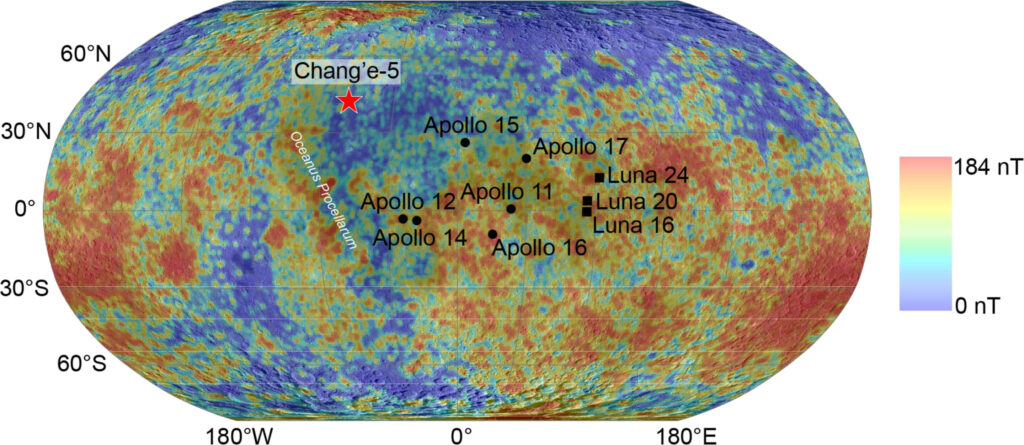The Moon has always held a special place in the human imagination, but its secrets extend far beyond the craters visible to the naked eye. A groundbreaking discovery from China’s Chang’e-5 lunar mission reveals that the Moon had a weak but persistent magnetic field approximately 2 billion years ago.
Unveiling the Moon’s Magnetic Field with Chang’e-5
The Chang’e-5 mission, launched in 2020 by the China National Space Administration, returned with 1,731 grams of lunar dust and rocks from the Moon’s Oceanus Procellarum. These samples, primarily basalt, offered scientists a pristine window into the Moon’s midlife. Researchers found evidence of a magnetic field ranging between 2,000 to 4,000 nanoteslas, persisting far longer than previously believed.

This discovery is particularly significant because earlier studies, based on Apollo and Luna mission samples, suggested the Moon’s magnetic dynamo ceased around 4 billion years ago. By extending this timeline, the Chang’e-5 samples challenge long-held assumptions about the Moon’s thermal evolution.
The Dynamo Effect: A Glimpse into the Moon’s Core
Magnetic fields on celestial bodies arise from the dynamo effect—a process driven by the movement of molten materials within a planet or moon’s core. In the Moon’s case, this movement likely occurred due to thermomechanical convection. The presence of a magnetic field indicates that molten material persisted beneath the Moon’s surface for billions of years, fueling volcanic activity and creating a protective shield against solar wind.
The discovery of a magnetic field during the Moon’s midlife reveals that its interior remained dynamic and thermally active far longer than anticipated. This prolonged activity suggests a slower cooling process, which could explain late-stage volcanism observed in the Moon’s history.
Why Is This Discovery Important?
1. Redefining Lunar Volcanism
The evidence of a midlife magnetic field aligns with signs of prolonged volcanic activity. Basalt samples returned by Chang’e-5 indicate lava flows occurring much later in the Moon’s timeline than previously thought. This challenges the notion that the Moon became geologically inert early in its history.
The implications extend beyond the Moon itself. Understanding how smaller celestial bodies sustain internal heat and activity over billions of years could help scientists better understand the evolution of other rocky planets and moons, including Mars.
2. Water Preservation on the Moon
One of the most exciting implications of this discovery lies in the potential preservation of water on the Moon. A magnetic field acts as a protective barrier, shielding a celestial body’s surface from solar wind. Without such protection, water molecules are broken down into hydrogen and oxygen, dispersing into space. The existence of a magnetic field 2 billion years ago suggests that the Moon may have retained more water during this period than previously estimated.
3. Insights into Planetary Magnetism
The Moon’s prolonged magnetic activity provides a valuable comparison to Earth’s much stronger and longer-lasting magnetic field.
How Scientists Uncovered the Moon’s Magnetic Past
The Chang’e-5 samples underwent meticulous analysis using state-of-the-art instruments. Scientists measured the magnetic properties of the basalt samples, detecting subtle remnant magnetization that preserved the Moon’s magnetic field from billions of years ago. This required extreme precision, as the magnetic signatures were faint and easily influenced by external factors.
This breakthrough was achieved through global collaboration. Chinese scientists worked alongside international researchers to compare findings with Apollo-era data. The integration of historical and new data provided a more comprehensive picture of the Moon’s magnetic evolution.
Challenges and Limitations
Detecting and interpreting magnetic signals from ancient rocks is no easy task. The faintness of the signals often makes it difficult to distinguish between true ancient fields and interference from later geological processes.
The Chang’e-5 mission focused on one region of the Moon. While the findings are groundbreaking, they represent a specific geological context. Future missions will need to collect samples from various regions to confirm whether these findings are globally applicable.
What’s Next for Lunar Research?
China’s lunar exploration program is far from over. The upcoming Chang’e-6 mission aims to collect samples from the Moon’s far side, potentially offering new insights into its geological and magnetic history.
Future missions from other space agencies, such as NASA’s Artemis program, may focus on investigating magnetic anomalies on the Moon. These anomalies could provide further evidence of localized or intermittent magnetic activity.
Understanding the Moon’s magnetic history and water preservation potential has practical applications for future lunar exploration.
Broader Implications for Space Exploration
The Moon’s magnetic history is more than a scientific curiosity; it has far-reaching implications for understanding planetary evolution and habitability. The findings suggest that smaller celestial bodies can sustain magnetic activity longer than expected, broadening the scope of astrobiology research. Could moons like Europa or Enceladus harbor magnetic fields that protect subsurface oceans from cosmic radiation? The Moon’s story may provide clues.
Moreover, studying lunar samples helps refine techniques that can be applied to Martian rocks and meteorites, aiding in the search for ancient magnetic fields and potential biosignatures.
Conclusion
The discovery of a 2 billion-year-old magnetic field on the Moon is a testament to the power of modern space exploration and collaborative science. By challenging long-held assumptions, this breakthrough redefines our understanding of the Moon’s history and opens new avenues for research into planetary evolution.
Reference:



















